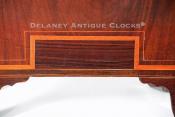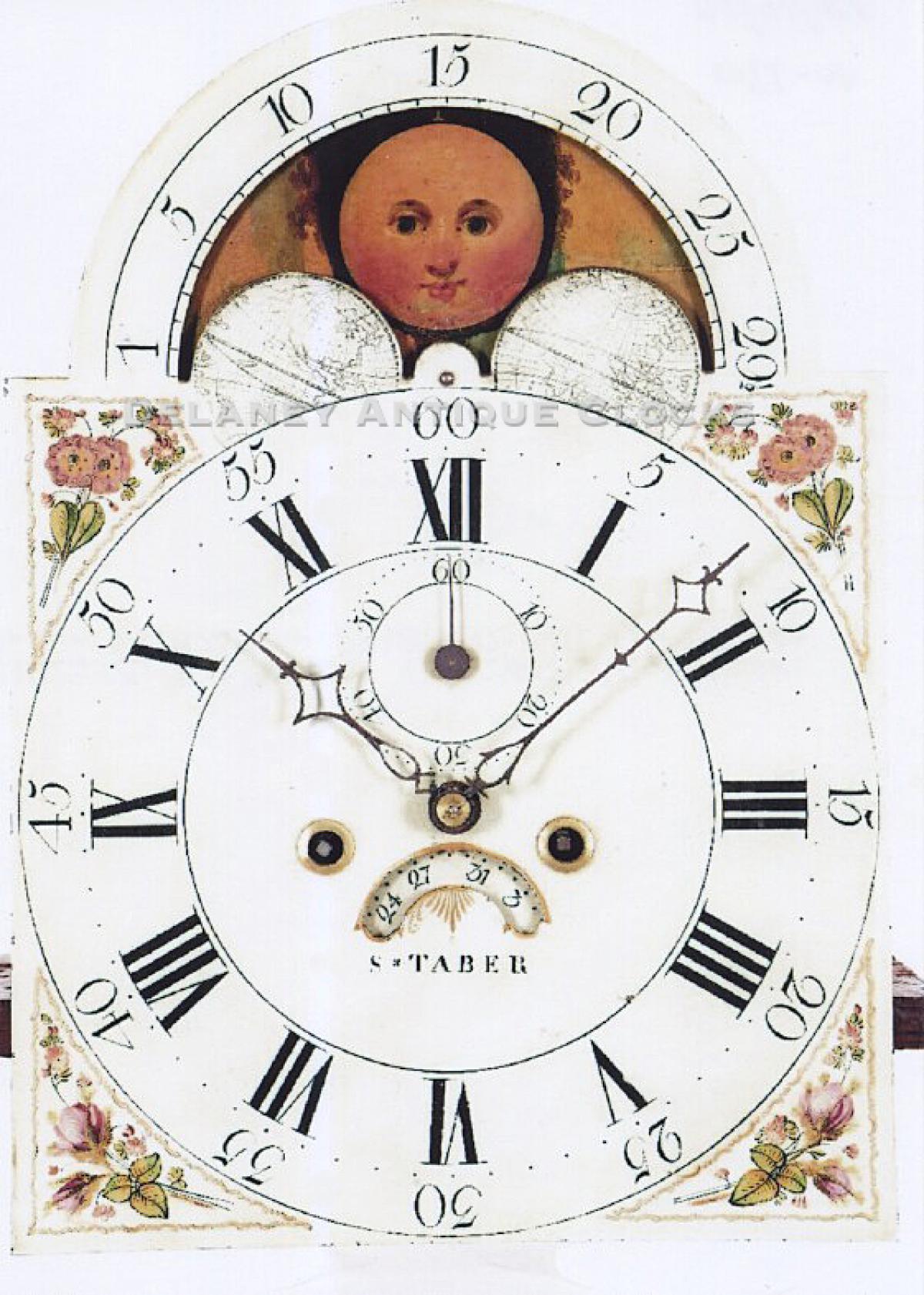Stephen Taber of New Bedford, Massachusetts. An Inlaid mahogany case tall clock. VV-130.
This will soon become the most famous of the Stephen Taber tall clock because it is illustrated and described in "Harbor & Home" Furniture of Southeast Massachusetts, written by Brock Jobe, Gary Sullivan, and Jack O'Brien 1710 -1850. This very clock is pictured and described on pages 274 and 275, plates 92 and 92.1. Stephen was Willard trained, and many of his known clocks feature Roxbury cases. This example is one of approximately a dozen that feature cases made in the New Bedford area and exhibits a more regional styling, including the fret pattern, French-style feet that feature horizontal grain orientation, and the formatting of the case inlays. It is suggested that Rueben Swift may have been the cabinetmaker for this example. This is supported by a record of him purchasing clock hardware for six clock cases from merchant Daniel Ricketson.
This is a very nice and clean mahogany case example. It features excellent mahogany veneers. The form reflects a strong New Bedford influence. This case stands on four nicely shaped applied French feet. It is interesting to note that the grain of the feet is oriented horizontally. This is consistent with furniture made in southeastern Massachusetts. The base panel is framed with a thin cross-banded border of tiger maple that is separated from the center panel by a thin strip of mahogany and a thin lighter line inlay. The design feature of note is the inlaid rosewood veneered panel found in the lower section of the base panel. This is an unusual and very attractive detail. The waist section is long and is fitted with a large rectangular waist door that exhibits a vibrant crotch veneer pattern. This door is trimmed with the same inlay pattern exhibited in the base section. The sides of the waist are fitted with brass stop-fluted quarter columns. These terminate in brass quarter capitals. The bonnet is of the fretwork style. Three-line inlaid plinths each support a brass ball and spike finial. Brass stop fluted bonnet columns, mounted in brass capitals, flank the bonnet door. This line inlaid door opens to access to a colorfully painted iron dial.
This dial is signed "S. TABER" above the numeral six within the time track. This painted time track, or the time ring, is formatted with Roman-style hour numerals. Each of the five-minute markers and the subsidiary seconds ring are displayed in an Arabic format. In the arch of this dial is a lunar calendar or moon phase mechanism. The four spandrel areas are colorfully decorated with floral patterns.
This fine movement is constructed in brass and is of good quality. Four turned pillars support the two brass plates. Hardened steel shafts support the polished steel pinions and brass gearing. The winding drums are grooved. The escapement is designed as a recoil format. The movement is weight driven and designed to run for eight days on a full wind. It is a two-train or a time-and-strike design having a rack and snail striking system. As a result, it will strike each hour on the hour. This is done on a cast iron bell mounted above the movement.
This clock was made circa 1811 and stands approximately 7 feet 5.5 inches or 89.5 inches tall to the top of the center final and 19.25 inches wide at the upper hood molding.
Inventory number VV-130.
Stephen Taber was born on October 23, 1777, in New Bedford, Massachusetts, and died there on September 10, 1862. His older brother Elnathan was nine years his senior and had moved North to Roxbury, where he served his clockmaking apprenticeship under Simon Willard. Simon considered Elnathan a highly skilled mechanic and his best apprentice. Elnathan remained in Roxbury after his indenture and continued to build clocks for himself and others in the Roxbury group of Clockmakers. Because of Elnathan's success, it is logical to assume that Stephen was also attracted to the clockmaking community in Roxbury. Stephen was trained in Boston by Aaron Willard, Simon's younger brother. By 1798, Stephen is recorded in the town of Roxbury's Tax Records as a Roxbury resident. This would suggest that he moved to Roxbury to start his apprenticeship sometime in 1791-92 at the age of 14. After serving his apprenticeship, he stayed in Roxbury for one year and returned to New Bedford in 1799. Here he advertised in October of that year that "Stephen Taber, (Late apprentice to Mr. Aaron Willard, Clock-Maker in Boston) Respectfully informs the public That he carries on the Clock Making Business... at his shop in Union Street..." From this time until he died in 1862, it appears that he lived and worked primarily in New Bedford. He is also listed as working in Acushnet for a short time. Over the later part of his life, the extent of his clockmaking trickled off as the years passed. This is assumed because he was more commonly listed as a merchant or trader by 1810. By 1860, his estate was valued at over $100,000. At the time of his death in 1862, his wealth had almost doubled. He married Elizabeth Sprague Pitcher in 1824. After he died in 1862, she became a philanthropist. She was one of the founding members of Tabor Academy in the town of Marion.












